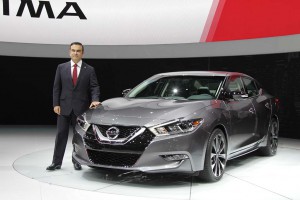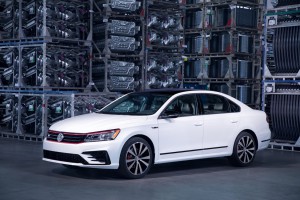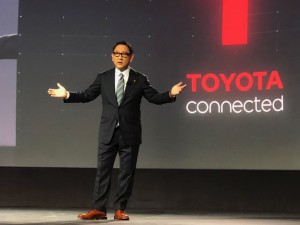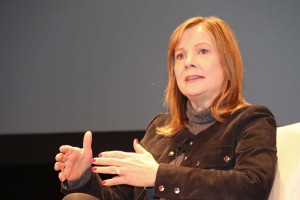
Carlos Ghosn, shown at the debut of the latest Maxima, has turned the Renault-Nissan-Mitsubishi Alliance into a global juggernaut.
The global auto industry has a new king-of-the-hill, the Renault-Nissan Alliance, which got a helping hand with the inclusion of the long-troubled Japanese automaker Mitsubishi.
Combined together, the three members of the Franco-Japanese alliance sold 10.61 million vehicles during 2017, narrowly topping Germany’s Volkswagen AG. Toyota, which had led the sales charts for much of the past decade before itself being toppled by VW last year, slipped into third.
“This evolution reflects the breadth and depth of our model range, our global market presence and the customer appeal of our vehicle technologies,” said Carlos Ghosn, the chairman and CEO of the Renault-Nissan-Mitsubishi Alliance and CEO of both Renault and Mitsubishi.
What had been just the Renault-Nissan Alliance was formed in 1999 when the French company came in to bail out the struggling Japanese automaker. Together, they had been moving up the sales charts in recent years, driven by Ghosn’s push to capture market share and build margins. But the critical move came in 2016 when Mitsubishi acknowledged it had cheated on mileage tests for vehicles sold in Japan. As its stock crashed, Nissan purchased a controlling stake, the smaller Japanese company’s sales last year being rolled into the alliance total for the first time.

VW continues to struggle in the key U.S. market but hopes to gain momentum with new product like this Passat GT launched at the Detroit Auto Show.
Individually, the three partners would have lagged well down on the sales chart, however. Nissan had the largest volume of the group, at 5.82 million last year, followed by Renault, at 3.76 million, and Mitsubishi, at 1.03 million.
(Nissan‘s XMotion Concept signals its new design direction. Click Here to check it out.)
Ghosn has since set a target of 14 million annual sales by 2022, while pledging to use the increased economies of scale between the three partners to slash costs and boost revenues and earnings.
Volkswagen is following a similar approach, albeit relying on the shared benefits of owning a dozen different passenger car brands – ranging from entry-level Seat to ultra-luxurious Bentley – as well as several truck brands. Despite a series of setbacks, including the revelation it had cheated on diesel emissions tests, the German marque was able to nudge its way to the top of the global hill, besting Toyota in 2016. At 10.53 million, its sales narrowly fell short of the Renault-Nissan-Mitsubishi Alliance last year, however.
(VW calls “incomprehensible” its participation in human and monkey tests of exhaust emissions. Click Here for the breaking news.)
Toyota has suffered a few setbacks of its own that set back its own ambitions. And while CEO Akio Toyoda is expecting a sales boost in 2018, it isn’t clear he has set the target high enough to regain the global crown.

Toyota CEO Akio Toyoda is not only pushing for automotive sales growth, but leading the company into the emerging mobility sector.
Under Toyoda, grandson of the company’s found the Japanese giant has broken with tradition. It not only has made acquisitions, such as the purchase of little rival Daihatsu, but also formed a number of joint ventures. That list includes projects with both Suzuki and Mazda. The latter, based in Hiroshima, is partnering with Toyota on both the development of new battery-electric vehicles and the construction of a new assembly plant in Alabama where some of those green machines will be built.
The global sales hierarchy has been undergoing a shake-up for much of the past decade. Several other manufacturers have been moving up the chart, notably including South Korea’s Hyundai-Kia. But that company stumbled sharply in 2017, with sales of just 7.25 million, about 1 million short of its original forecast. A shortage of SUV models didn’t help.
(Click Here to check out the new 2019 Toyota Avalon.)
Moving in the other direction is General Motors, the giant American manufacturer that really pioneered the concept of global scale. But, under Chairman and CEO Mary Barra, GM has adopted a new approach that some have dubbed “right-sizing.” Barra has intentionally chosen to focus on only GM’s most promising operations, while dumping those that show little potential.
Since taking the reins four years ago she has led GM out of Russia, South Africa and Venezuela, and while it continues to manufacture vehicles in India it is no longer selling products there, using its Indian plants solely for export. The biggest move came last year with the sale of the German-based Opel-Vauxhall unit to France’s PSA Group.
While GM sales in China have grown rapidly in recent years it is not expected to again make a bid or global leadership. On the other hand, shedding losses in markets like Europe saw its profits jump, with margins rising to 6.8% for the first three quarters of 2017, well ahead of the various partners in the Renault-Nissan-Mitsubishi Alliance.
(GM expecting to report big profits for 2018. Click Here for the story.)


I like GM’s move; no need to try to build / sell product where it is not wanted.